Why Now Is the Best Time to Experience the Surreal Beauty of the Largest National Park in the Lower 48

When is the best (and worst) time to visit the lowest, hottest, driest point in all of North America?
After spending a few years living in California, the lower stretch of Highway 395 became my city escape. I ended up visiting Death Valley three times in just two years, an aborted attempt during late summer and twice in late fall. So, if there’s one advice you should remember from this article, it’s never going in the summer. My brain cells are still recuperating from the trauma of the scorching heat.
The climate in Death Valley National Park ranges from sweltering summers of 125+ degrees Fahrenheit to mild winters. It actually holds the highest recorded temperature on Earth, at 134°F! So, let’s take a look at the visitor seasons at Death Valley:
- Peak Season: Mid-October to Early-April
- Shoulder Seasons: March to May and October to November
- Off-Peak Season: May to September
Next, I’ll delve into the specifics of the seasons, must-see events, and monthly weather breakdown. Whether you’re planning a day trip to Death Valley or a longer stay, photographing the salt flats, or hiking Dante’s View, these are the best times to go to Death Valley National Park.
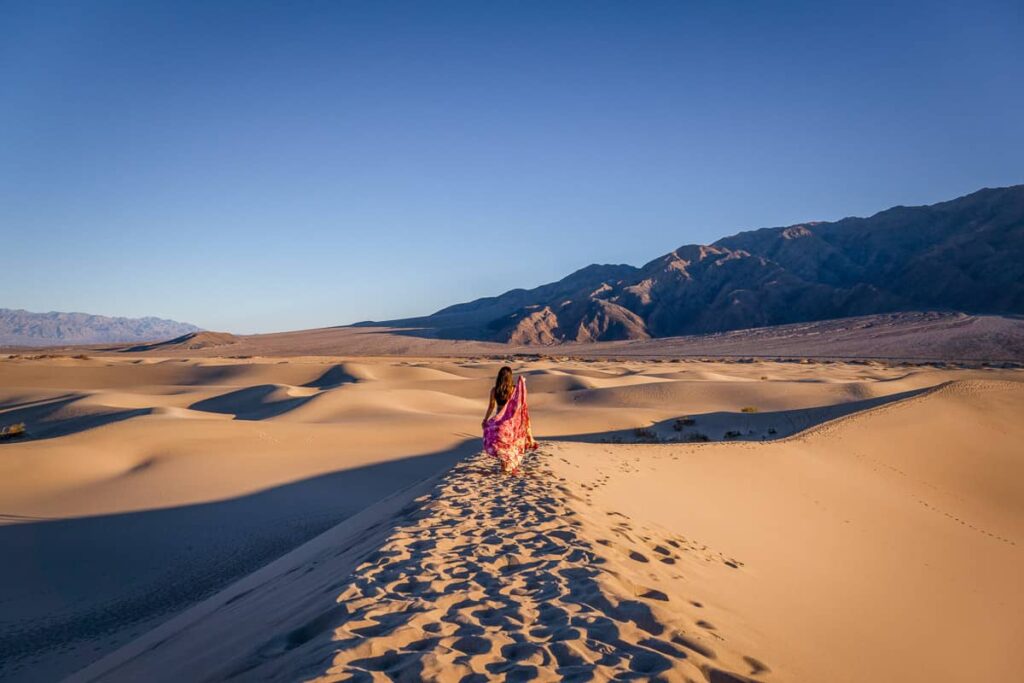
Best Time to Visit Death Valley National Park
Best Season to Visit
The best time to visit Death Valley National Park is late fall and spring. October is when the temperatures start to drop, at least enough to walk short distances and not at the height of the day. But wait until November, and doing longer hikes is much more comfortable.
Spring is extremely popular because, in addition to nice weather, the wildflowers are in full bloom! It’s a California bucket list thing to see.
The temperatures may sway day to day, year to year. One of my visits was in mid-October, and it was still uncomfortably hot.
Best Time for Good Weather
For the best weather, plan your visit between mid-October and mid-April. During these months, the daytime temperatures are around 70 to 75°F. The desert evenings are cool and crisp, usually dropping to the lower 50s°F. It’s perfect for a cozy campfire chat or a peaceful stargazing session. Any remaining haze from wildfires should also disappear by early October.
Best Time for Smaller Crowds
If you want to avoid the crowds and have a more chill experience, come to Death Valley National Park during the shoulder seasons, as close to summer as you can handle. The closer you get to June to September, the less busy it will be because of the crazy heat, with temperatures often over 120°F. You might even have popular spots like Zabriskie Point or Badwater Basin, mostly to yourself, with just a few other adventurous folks around.
However, about 1/5 of the yearly visitors still go in the peak summer months because of holiday breaks.
Danger! Just like excessive heat can overheat your engine, hiking, especially during mid-day, can lead to heatstroke.
Cheapest Time to Visit
The cheapest time to visit is during the off-peak summer months. During this time, lodging costs drop significantly, with motel rooms generally costing up to $200 during peak season, falling to half the price. With that said, camping is the cheapest option for accommodation, and many are closed in the summer due to the extreme heat.
Best Time for Stargazing
Death Valley National Park, an International Dark Sky Park, offers impressive stargazing. The best time for clear, starry skies is during the new moon phase in the cooler months between November and April, when the air is less hazy and the skies are clearer.
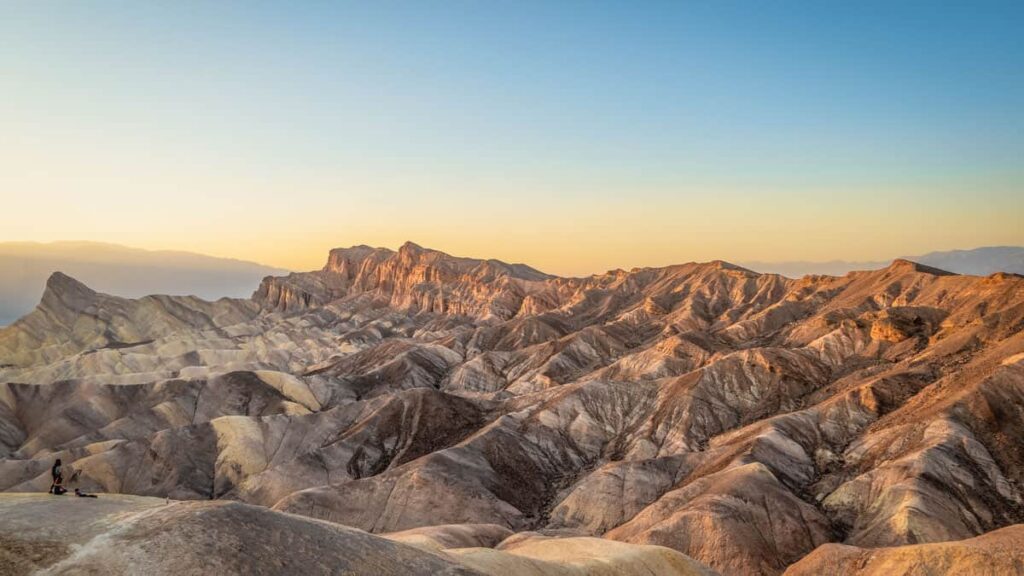
Worst Time to Visit
The blistering summer months are the worst time to visit Death Valley National Park. The scorching desert temperatures during this period can often exceed 120°F, making any outdoor activity potentially hazardous. The intense heat and lack of shade can turn even a leisurely stroll into a dangerously exhausting endeavor.
📖 Read Also: 10 Hottest National Parks in the US to Avoid This Summer
Park Closures
Death Valley National Park is open all year round, 24 hours a day. The Furnace Creek Visitor Center & Museum is open daily from 8:00 AM to 5:00 PM.
Some areas may be closed due to flash floods or active road work. But there are no planned annual shutdowns.
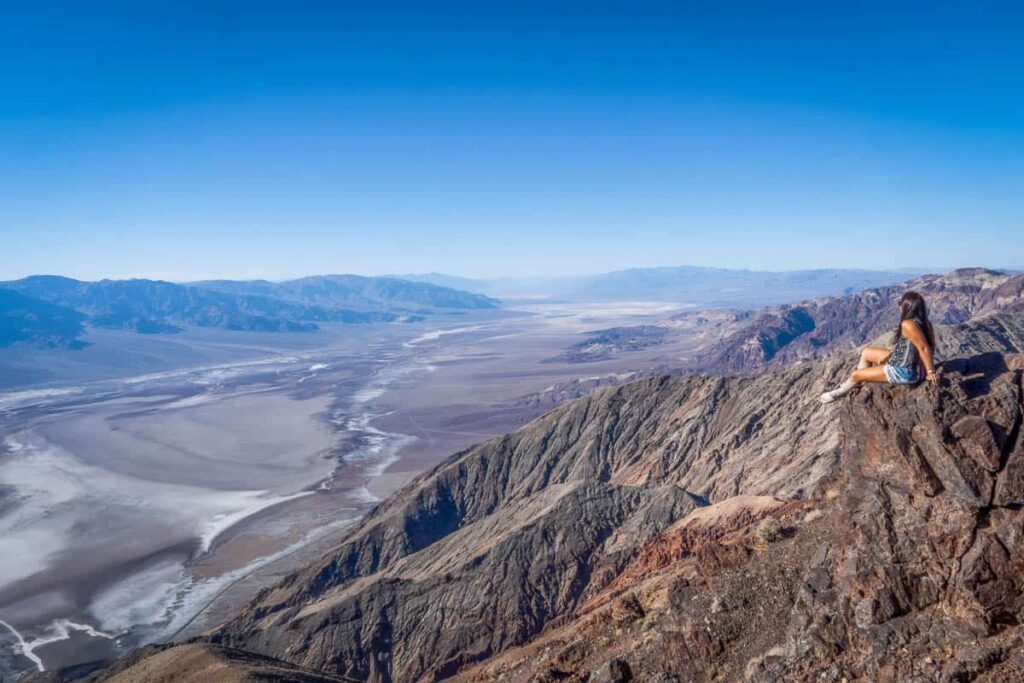
Seasons at Death Valley National Park
Spring (March to May)
Springtime in Death Valley National Park is when the desert landscapes burst into a display of wildflowers. I’ve photographed this exquisite floral phenomenon firsthand. The lower elevations are the first to transform into a canvas of vibrant colors. During a particularly rainy year, I was lucky enough to experience a “super bloom” where entire fields were engulfed in a sea of orange and yellows.
Spring is an awesome time for hikers to explore the park’s extensive trail network. The temperatures are super comfortable for outdoor activities, usually ranging from 70 to 90°F during the day and dropping to a pleasant 50 to 65°F at night.
Death Valley is a major migration spot for many species. Plus, the park’s mammal residents, like the Desert Bighorn Sheep and Coyotes, are more active as they search for water and food in the milder weather.
Regarding crowds, the park can get pretty busy in spring, especially around Easter and during the wildflower bloom. So, if you’re after solitude, hitting the park earlier in spring or on weekdays might be your best bet. The park’s campgrounds and accommodations tend to fill up fast during this time.
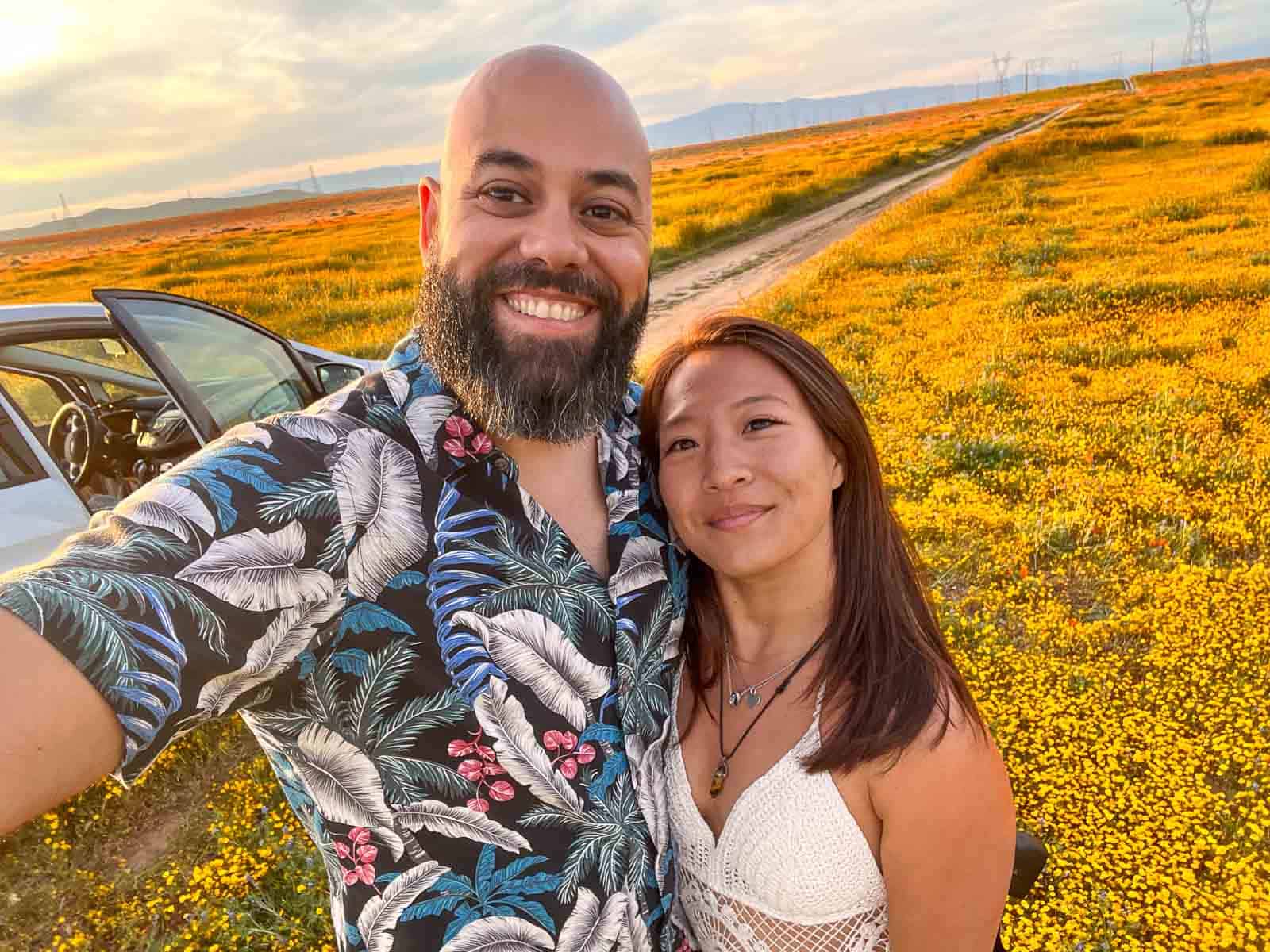
Summer (June to September)
Summer in Death Valley National Park is synonymous with scorching heat! The temperatures can reach a mind-boggling 120°F, and even peak at a jaw-dropping 130°F in the afternoons. Not fun.
While most people might think twice about visiting under these extreme conditions, some adventurers see it as part of the Death Valley experience. But remember, safety first!
Believe it or not, summer nights in the park can be surprisingly pleasant. Temperatures drop dramatically after sunset, making the nights cool and bearable. It’s the perfect time for some stargazing! However, late in the summer is California’s dreaded wildfire season, where faraway smoky air drifts into the desert, causing haze and even hotter weather.
For those seeking solitude, summer in Death Valley is a hidden gem. The fewer crowds mean you can enjoy the popular sites in peace.
Fall (October to November)
Fall in Death Valley National Park marks a shift from scorching summer heat to more pleasant 70 to 90°F, making outdoor activities like hiking and sightseeing much more enjoyable. Nights get cooler too, ranging from 50 to 65°F.
If you’re into wildlife, many creatures become more active during the cooler parts of the day, so you might catch a glimpse of kit foxes, coyotes, or even a speedy Roadrunner.
Having come during this time, I recommend coming as late in the shoulder season as possible to avoid unseasonable hot days.
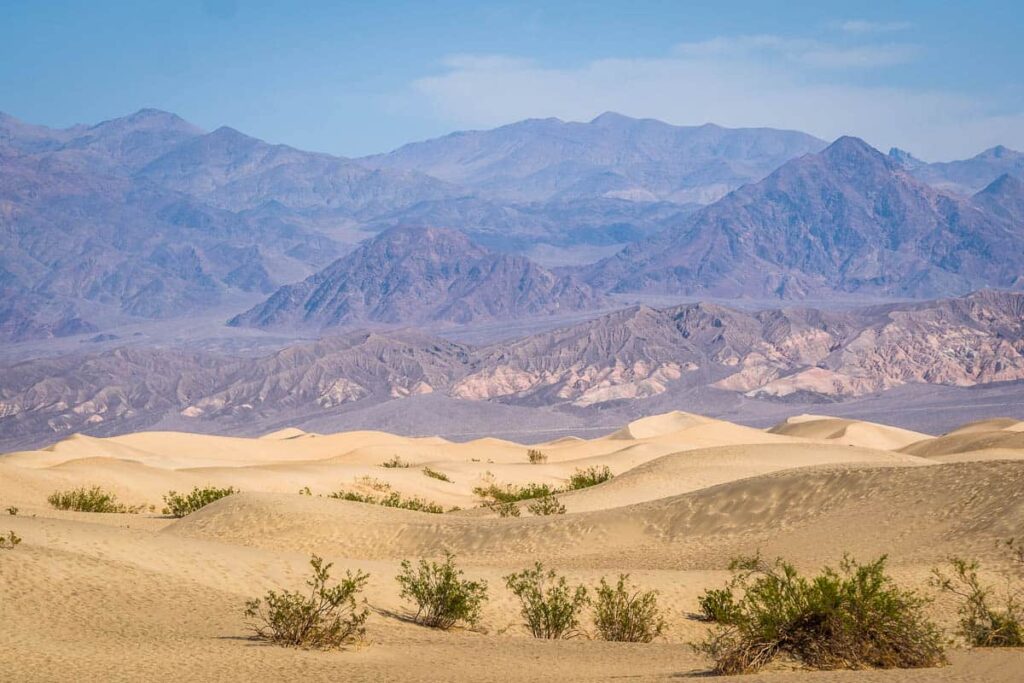
Winter (December to February)
As winter sets in, the fierce heat of the previous months gives way to milder conditions ranging from 60 to 70°F. Being a desert, once the sun sets, the nighttime brings a chill as temperatures often dip to between 40 and 50°F, sometimes even below freezing.
Trails that were off-limits during the scorching months are now calling for hikers. The crystal-clear desert skies are a sight of stars, free from light pollution.
Wildlife sightings vary in winter. While some critters go into hibernation, you might still spot active ones like the elusive Coyote and the rare Bighorn Sheep roaming around the park. Birdwatchers can also catch winter migratory species passing through the area.
Death Valley Weather By Month
Here is a month-by-month breakdown of the average high and low temperatures and precipitation at Death Valley National Park:
Best Time of Day to Visit
Sunset is arguably the best time of day in Death Valley. I’m torn between two fantastic sunset spots, Zabriskie Point, and hiking the tallest dune in Mesquite Sand Dunes. As the sun dips below the vast desert horizon, the badlands and sand of the desert landscape turn vibrantly warm against the stark landscape. Following right after, the cooler temperatures make for a peaceful stargazing opportunity.
Park Breakdown by Time of Day
- Morning (Sunrise to 11 AM): Early morning is the best time for hiking with relatively cooler temperatures. Wildlife is also more active.
- Midday (11 AM to 3 PM): It’s the peak of the day with higher temperatures. It’s best to avoid strenuous activities during this time.
- Afternoon (3 PM to Sunset): The temperatures start to drop, making it the perfect time for light activities and exploration. It’s also the golden hour for photography.
- Evening (Sunset to Sunrise): Cool temperatures and clear skies make for perfect stargazing conditions.
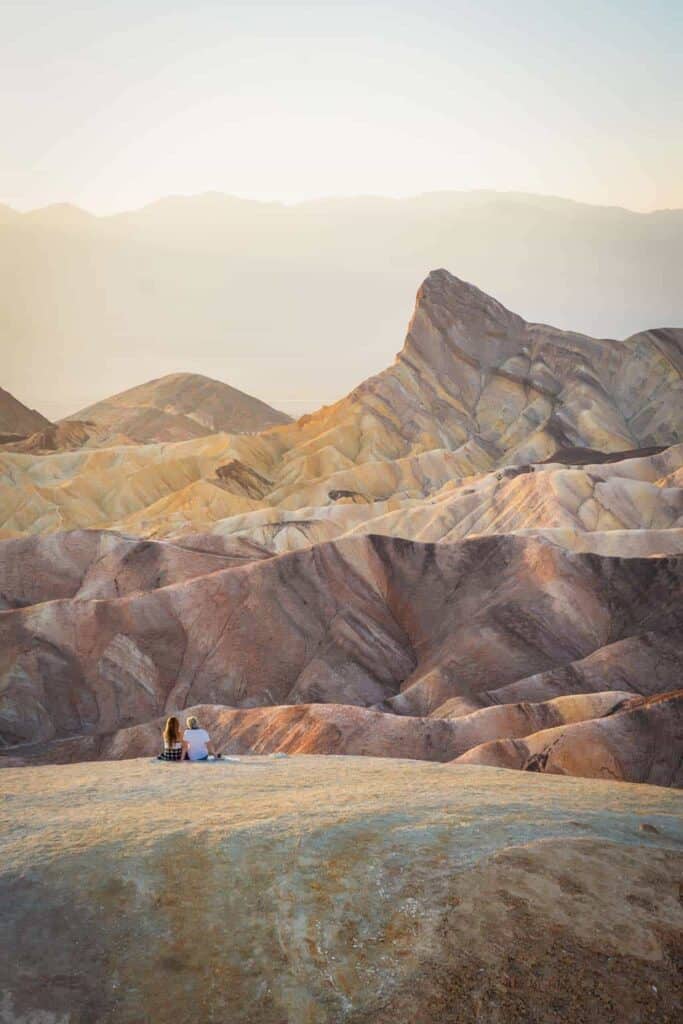
Special Events or Festivals
Here are some special events and festivals that take place in or near Death Valley National Park:
- Death Valley Dark Sky Festival: This annual spring event invites visitors to explore the night sky and the unique park landscapes.
- Death Valley Trail Marathon: This trail marathon takes participants running through an extreme landscape.
- ’49ers Encampment: Celebrating the Gold Rush ’49ers who trekked across Death Valley, this encampment takes place at Furnace Creek and features live entertainment.
- California Dark Sky Festival: Held in mid-November, this festival celebrates the dark desert skies of California.
Before you Close That Tab…Where to Next in California?
I’ve lived and vanlifed around, about, and through all of California for 3 years. If you’re looking for more information on California, check out these other destination itineraries.
- Perfect One Day In Lassen Volcanic National Park Itinerary
- Perfect One Day In Redwood National Park Itinerary
- Perfect One Day In Joshua Tree Itinerary For First-Timers
- One Day In Death Valley Itinerary For Adventurers
- Perfect One Day in San Diego Itinerary: What Not to Miss
- Perfect One Day in San Francisco Itinerary for First Timers
- Day Trip to Lake Tahoe: One Day Itinerary for All Seasons
- Perfect Day Trip to Sonoma Itinerary for Wine Lovers
- Perfect Day Trip to Napa Valley Itinerary for Wine Lovers
- Perfect One Day in Los Angeles Itinerary from a Local
Catherine, a seasoned travel writer, has lived in 4 different states and explored 36 states and 28 national parks. After spending two years embracing van life, she's now dedicated to sharing her vast knowledge of day trips across America. Catherine's other works has been referenced in major publications like MSN, Self, and TripSavvy.
| MY FAVORITE TRAVEL RESOURCES |
✈️ Find amazing guided tours and experiences with Viator to maximize your time! 🏘️ Plan ahead and secure your accommodation with Booking.com in advance. 🧾 Rent a car with Discovercars in advance and get the best prices for your day trip adventures. |

